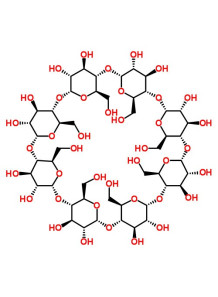Gamma Cyclodextrin (γ-Cyclodextrin)
- Product Code: 35821
a type of cyclic oligosaccharide composed of eight glucose units linked by α-1,4-glycosidic bonds. It is commonly used in the food industry for its ability to form inclusion complexes with various molecules, which can improve the solubility, stability, and bioavailability of certain ingredients
a type of cyclic oligosaccharide composed of eight glucose units linked by α-1,4-glycosidic bonds. It is commonly used in the food industry for its ability to form inclusion complexes with various molecules, which can improve the solubility, stability, and bioavailability of certain ingredients
Gamma-cyclodextrin is a type of cyclic oligosaccharide composed of eight glucose units linked by α-1,4-glycosidic bonds. It is commonly used in the food industry for its ability to form inclusion complexes with various molecules, which can improve the solubility, stability, and bioavailability of certain ingredients.
Uses of Gamma-Cyclodextrin in Food
Flavor Enhancement and Stabilization:
Gamma-cyclodextrin can encapsulate volatile and sensitive flavor compounds, protecting them from degradation and volatilization. This helps in maintaining the flavor profile of food products over time.
Reduction of Off-Flavors and Odors:
By forming complexes with compounds that cause undesirable tastes or smells, gamma-cyclodextrin can mask off-flavors and odors in food products.
Improved Solubility and Bioavailability:
Some vitamins, antioxidants, and other bioactive compounds have limited water solubility, which affects their absorption in the body. Gamma-cyclodextrin can enhance their solubility and, consequently, their bioavailability.
Fat Replacement:
Gamma-cyclodextrin can mimic the texture and mouthfeel of fats, making it useful in developing low-fat or fat-free food products without compromising on texture.
Stabilization of Sensitive Ingredients:
Ingredients such as vitamins, fatty acids, and probiotics can be stabilized by gamma-cyclodextrin, protecting them from heat, light, and oxygen during processing and storage.
Examples of Application
Dairy Products: Gamma-cyclodextrin is used in yogurt and cheese to stabilize flavors and improve texture.
Beverages: It can be used to enhance the solubility of hydrophobic vitamins and flavors in beverages.
Bakery Products: In baked goods, gamma-cyclodextrin can help retain moisture and improve the shelf life.
Nutraceuticals: It is often used in dietary supplements to improve the bioavailability of active ingredients like curcumin and coenzyme Q10.
Regulatory Status
Gamma-cyclodextrin is generally recognized as safe (GRAS) by the FDA in the United States. It has also been approved for use in food products by the European Food Safety Authority (EFSA) and other international food safety agencies, provided it is used within the recommended limits.
| Mechanism | - |
| Appearance | - |
| Longevity | - |
| Strength | - |
| Storage | - |
| Shelf Life | - |
| Allergen(s) | - |
| Dosage (Range) | - |
| Recommended Dosage | - |
| Dosage (Per Day) | - |
| Recommended Dosage (Per Day) | - |
| Mix Method | - |
| Heat Resistance | - |
| Stable in pH range | - |
| Solubility | - |
| Product Types | - |
| INCI | - |
Purchase History for
Cart
No products



